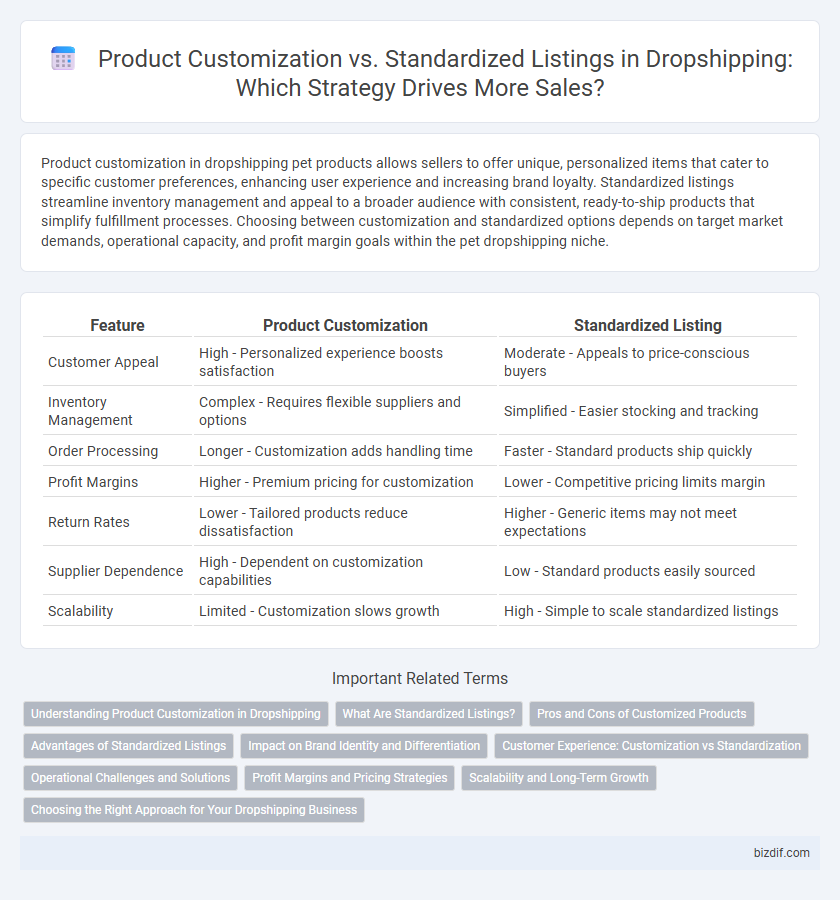Product customization in dropshipping pet products allows sellers to offer unique, personalized items that cater to specific customer preferences, enhancing user experience and increasing brand loyalty. Standardized listings streamline inventory management and appeal to a broader audience with consistent, ready-to-ship products that simplify fulfillment processes. Choosing between customization and standardized options depends on target market demands, operational capacity, and profit margin goals within the pet dropshipping niche.
Table of Comparison
| Feature | Product Customization | Standardized Listing |
|---|---|---|
| Customer Appeal | High - Personalized experience boosts satisfaction | Moderate - Appeals to price-conscious buyers |
| Inventory Management | Complex - Requires flexible suppliers and options | Simplified - Easier stocking and tracking |
| Order Processing | Longer - Customization adds handling time | Faster - Standard products ship quickly |
| Profit Margins | Higher - Premium pricing for customization | Lower - Competitive pricing limits margin |
| Return Rates | Lower - Tailored products reduce dissatisfaction | Higher - Generic items may not meet expectations |
| Supplier Dependence | High - Dependent on customization capabilities | Low - Standard products easily sourced |
| Scalability | Limited - Customization slows growth | High - Simple to scale standardized listings |
Understanding Product Customization in Dropshipping
Product customization in dropshipping allows sellers to offer personalized products tailored to individual customer preferences, enhancing customer satisfaction and brand loyalty. By integrating print-on-demand services or customizable product options, dropshippers can differentiate their stores from competitors relying on standardized listings. Understanding the logistics, such as supplier capabilities and order fulfillment times, is crucial for effectively managing customizable products and ensuring a seamless customer experience.
What Are Standardized Listings?
Standardized listings in dropshipping refer to pre-defined product descriptions, images, and specifications provided by suppliers or marketplaces that ensure uniformity across multiple sellers. These listings streamline the sales process by offering consistent information, reducing the effort needed to create unique content for each product. Using standardized listings helps maintain product accuracy and comparability but limits sellers' ability to differentiate through customization.
Pros and Cons of Customized Products
Customized dropshipping products offer unique value through personalization, boosting customer satisfaction and brand differentiation, but they require longer production times and increased supplier coordination, which can complicate inventory management. Standardized listings streamline operations and reduce delivery times, yet they often face intense competition and lower profit margins due to lack of uniqueness. Balancing customization benefits with operational challenges is crucial for maximizing ecommerce success in dropshipping models.
Advantages of Standardized Listings
Standardized listings in dropshipping streamline the sales process by offering consistent product descriptions, images, and specifications, which enhance customer trust and improve search engine rankings. They enable faster inventory management and order fulfillment by using uniform templates, reducing errors and operational costs. Additionally, standardized listings simplify marketplace compliance and facilitate easier integration with multiple sales channels like Amazon and eBay.
Impact on Brand Identity and Differentiation
Product customization in dropshipping enhances brand identity by offering unique, tailored products that differentiate sellers from competitors, fostering customer loyalty and perceived value. Standardized listings simplify inventory management but risk brand homogenization, making it challenging to stand out in a crowded marketplace. Investing in personalized options creates a distinct market position, strengthens brand recognition, and drives higher customer engagement.
Customer Experience: Customization vs Standardization
Product customization in dropshipping enhances customer experience by offering personalized products that cater to individual preferences, leading to higher satisfaction and brand loyalty. Standardized listings streamline the purchasing process with consistent product options, appealing to customers seeking quick and straightforward decisions. Balancing customization with standardized listings allows dropshippers to meet diverse customer needs while maintaining operational efficiency.
Operational Challenges and Solutions
Product customization in dropshipping introduces operational challenges such as increased handling time, complex inventory management, and higher error rates in order fulfillment compared to standardized listings. Solutions include implementing advanced order management systems that automate customization requests and integrating real-time inventory tracking to minimize stock discrepancies. Streamlining communication channels between suppliers and customers also reduces misunderstandings and enhances operational efficiency.
Profit Margins and Pricing Strategies
Product customization in dropshipping allows sellers to charge premium prices and increase profit margins by offering unique, tailored products that meet specific customer demands. Standardized listings cater to broader markets but often compete on price, leading to thinner margins due to intense competition and lighter differentiation. Strategic pricing in customized products involves value-based pricing models, whereas standardized products rely heavily on competitive pricing and cost efficiency to maintain profitability.
Scalability and Long-Term Growth
Product customization in dropshipping allows for niche targeting and higher profit margins but often limits scalability due to increased supplier coordination and inventory complexity. Standardized listings streamline operations, enabling faster order processing and easier inventory management, which supports long-term growth by maintaining consistent customer experiences. Balancing customization with efficient, scalable systems is key to sustaining expansion and competitive advantage in competitive dropshipping markets.
Choosing the Right Approach for Your Dropshipping Business
Product customization in dropshipping allows sellers to offer unique, personalized items that can increase customer satisfaction and brand loyalty, making it ideal for niche markets. Standardized listings streamline inventory management and simplify marketing efforts, proving effective for high-demand, mass-market products. Evaluating your target audience, product complexity, and operational capacity helps determine whether customization or standardization aligns best with your dropshipping business goals.
Product Customization vs Standardized Listing Infographic

 bizdif.com
bizdif.com